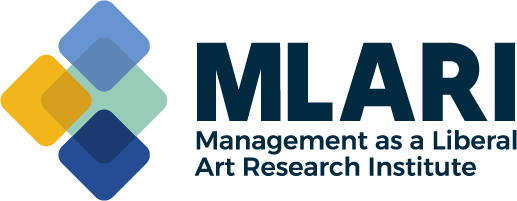Do Words Matter?
PUBLISHED:
Peter Drucker's distinction between language and communication
Peter Drucker made a clear distinction in his writing between language and communication. For Drucker, language was part of culture. It was “substance…the cement that holds humanity together. It creates community and communion” (Drucker, 1992). Language was not just communication. It was something much more important. In our current time, I don’t think we share this respect for language. With the explosion of social media, it has become too easy to type a few words into a text or a tweet, or even an email, and expect that the reader will understand the essence of that communication.
I’ve been leading a course on Drucker Philosophy and Theory 101 for faculty and administrators at CIAM, as well as participants from MLARI, since the summer. Although we’ve been delving into the intricacies of Drucker’s ideas and how to implement them, our sessions have focused on Drucker’s language; what did Drucker actually SAY about topics such as a functioning society of organizations, or management as a liberal art? What role do words play in how we interpret meaning – in short, how do words function in communication?
Communication can take many forms that are nonverbal: body language, facial expression, tone, etc. These are very important, particularly as we emerge from a remote world where many of us are rusty in using these kinds of communication skills. But the role of verbal communication is crucial to any society, particularly a society of organizations where people need to convey complex ideas and information.
Drucker was well aware of the problem of communicating. In a paper presented in 1969, he stated that “communications has [sic] proven as elusive as the Unicorn” (Drucker, 1993, p. 320). Despite the increased focus on the subject, managers in the mid-twentieth century were woefully poor at this skill. Can we argue that the same is not true for today in any sector (government, for-profit, health care, education) save for some exceptions?
I suppose we need to clarify what “effective communication” looks like. In today’s world, communication can look like a Zoom meeting, a tweet, a social media post, a highly-scripted interview, or an administratively-driven process of internal interactions. Are these effective forms of communication for organizations? They can be, but, if misused or poorly crafted, they can be remarkably ineffective.
In his seminal work, Management: Tasks, Responsibilities, Practices (1974), Drucker cited four fundamentals of communication:
· Communication is perception
· Communication is expectation
· Communication makes demands
· Communication and information are different and indeed largely opposite – yet interdependent (Drucker, 1974, p. 391).
Much of this material derives from the 1969 paper presented to the Fellows of the International Academy of Management in Tokyo.
Communication is perception: Drucker has a lot to say about this, but I can summarize: Did he/she/they “get it”? You may be an incredible speaker (or writer), or you may not be. The point is: did your audience get what you were trying to convey? If not, why? Was it the words you used, the delivery, the body language, etc. It’s hard to admit that, even though you are a professional speaker or writer, “it is the recipient who communicates. The so-called communicator, the person who emits the communication, does not communicate. He or she utters. Unless there is someone who hears, there is no communication” (Drucker, 1974, p. 391). That’s a hard pill to swallow if you fancy yourself an eloquent speaker, leader, or teacher. But it really doesn’t matter, does it? What matters is whether or not your “utterance” was understood. And was it understood the way you intended? You may think you conveyed an idea or thought, but the language you used may have been perceived in a different way due to cultural differences, gender or ethnic conflicts, class inequalities, or other sources of miscommunication (see, for example, https://www.tandfonline.com/doi/full/10.1080/23311975.2017.1408943).
Our more recent problems with communication and perception have to do with virtual interactions that accelerated during the pandemic and have remained an integral part of how we talk to each other. Various platforms have attempted to upgrade their interfaces to improve communication, such as features that allow one to avoid seeing themselves (which can be distracting, as some tend to focus on their appearance rather than on the content of the meeting or the reactions of others). How can you assess the perception of your Zoom audience during a presentation? Especially when the cameras are turned off? Many have lost their perception skills because of the reliance on technology rather than face-to-face interactions. What does that emoji mean? How do I interpret the exclamation point in that text? Drucker’s first element of communication – perception – is difficult to assess virtually. Is it any wonder we are so poor at real communication today? (See https://www.harvardbusiness.org/wp-content/uploads/2020/03/HBR_How_to_Avoid_Virtual_Miscommunication-1.pdf, and https://www.forbes.com/sites/forbesbusinesscouncil/2021/10/07/zoom-gloom-is-real-how-to-improve-communication-and-connection-without-video/?sh=63c86ebd243d)
Communication is expectation: Humans try to make sense out of our worlds and assemble information into some kind of order. We all have a set of expectations based on experience that influence our processing of information. In Drucker’s words, “We see largely what we expect to see, and we hear largely what we expect to hear” (Drucker, 1974, p. 393). The unexpected is either ignored or largely misunderstood. People try to fit information into their existing framework or understanding of how things work.
We have to understand what people expect to see and hear before we can effectively communicate. If information fits within someone’s expectations, it will be perceived. If the message is contrary to the recipient’s expectations, that must be clearly signaled. The worst mistake is to attempt “a gradual change in which the mind is supposedly led by small steps to realize that what is perceived is not what it expects” (Drucker, 1974, p. 393). This only reinforces expectations. Instead, clearly communicate that “This is different!”, creating an awakening that breaks through expectations.
This is easier said than done! Such a signal can create a sense of panic or distress, as it implies the need for a change in approach, strategy, outlook, and/or tactics. In the United States, the poor messaging with respect to public health measures needed to combat the impacts of the COVID-19 pandemic illustrates the dangers of mismanaging human expectation in communications. In the early stages of the pandemic, when data were limited, public communications did not emphasize that this was, in fact, a novel coronavirus, and that the potential threat was unique and serious. As a result, much of the public discounted later attempts to curb mortality rates through lockdowns, distancing, and masking. The COVID-19 pandemic did not fit within anyone’s expectations (save for the handful of experts trained in virology and public health). Yet, other nations, notably Germany, Taiwan, and South Korea took the threat seriously, communicated it effectively, and managed to avoid significant deaths in the early stages of the pandemic. Researchers are evaluating the various responses to the pandemic, and how the public reacted to communications from scientists and government representatives (see, for example, https://www.sciencedirect.com/science/article/pii/S2212420921004775 and
https://journals.sagepub.com/doi/full/10.1177/09636625221093194
Communication makes demands: In his 1969 paper, Drucker used the subtitle “Communication is Involvement” (Drucker, 1993, p. 326). That header actual encapsulates his argument more effectively; he likely modified it to appeal to a management audience in his later work. Drucker says that communication “always demands that that the recipient become somebody, do something, believe something. It always appeals to motivation. If communication fits in with the aspirations, values and purposes of the recipient, it is powerful. If it goes against them, it is likely not to be received at all…By and large, therefore, there is no communication unless the message can key in to the recipient’s own values [emphasis mine],” (Drucker, 1974, p. 395). I think this is possibly the most important message Drucker gives us about communication. Real communication involves some kind of expectation of action. A salesperson asks for the order. A human resources manager requests her team to implement a new policy. A non-profit director asks volunteers to show up for an important event. Drucker remarks that “Communication is always ‘propaganda’” (Drucker, 1974, p. 394), but, frankly, I find his word usage ineffective here. Propaganda is associated with the misuse of language - the attempt to promote a biased perspective or a particular point of view. But the point that communication expects some kind of action - physical, intellectual, or spiritual – is important. Clear communication is not propaganda. It conveys information that is congruent with values that are shared by the individual and the organization (or the communicator). If a leader asks team members to participate in a project, the project needs to make sense in terms of the organization’s values and objectives, as well as the individual participants’ sense of purpose and meaning. This is why it is so critical for organizations to make sure that team members share the same values and goals of the larger institution. If individuals are not aligned with a higher purpose, their efforts are solely their own, with no greater function. Communication that asks them to do something for the “team,” or the “organization,” or “society” will not be received. Conversely, organizations need to make sure that they are communicating in a way that speaks to the motivations of the individual; how will that person grow from this experience? How will they become more effective in their role, or as a leader, or as a person?
Communication and information are different and largely opposite – yet interdependent: Information is pure. It is logic, without meaning, impersonal, and free of human intervention. Communication, however, is steeped in human intervention. Communication seeks to make meaning out of information. As Drucker noted in 1974, humans were awash in information, but lacking in ways of making sense out of that information: “…information is, above all, a principle of economy. The fewer data needed, the better the information. And an overload of information leads to information blackout. It does not enrich, but impoverishes” (Drucker, 1974, p. 395-396).
Fast forward to today, and we are in the same situation on steroids. Misinformation abounds on social media platforms, leading to political division and violence. Organizations are overwhelmed by data, struggling to find meaning in the mass of information. Data analytics has exploded as a field of study and application. Fifty years ago, Drucker commented that the information revolution of that age did not really produce information; it merely produced data (Drucker, 1974, p. 398). This is not communication. Communication involves understanding the human component: emotions, values, expectations and perceptions. Thus, communication and information are, as Drucker states, largely opposite, but yet they are interdependent, particularly today. How can we use information constructively in communications? By understanding the human component of communication.
So, do words matter? Do what we say and write make a difference in communication? Absolutely.
If communication is perception, it requires effectively conveying concepts or ideas in a way that another person can actually hear and comprehend. This may require using a variety of words to communicate; not everyone understands a particular term the same way, as words carry associations, cultural references, and other information. In our class, for example, we discussed the fact that Drucker’s use of the terms “conservative” and “liberal” can be very jarring for a modern audience, as those words today are particularly loaded politically. In Drucker’s writing, they are not; Drucker uses those terms in a historical context that is largely unfamiliar to a contemporary audience, particularly an American audience. In academia, the use of jargon is another example of where language can get in the way of perception. The term “rationality” in decision making has specific connotations that may be unclear to someone who comes from a humanities background, where “rationality” may mean something more philosophical. Particularly when we are attempting to discuss complex problems or subjects, our word choice can actually make a complicated subject more confusing.
If communication is expectation, we need to understand what our audience expects to hear, read, or see. What is “expected” for this particular person or group of people? Can we use language that fits with their worldview or perspective? Or do we need to signal clearly that something is out of the ordinary? Some individuals are more flexible and open to change; they are resilient in the face of adversity and have coping skills to adapt. Others are less capable in this area; they fear change and prefer routine and the safety of predictability. If you are introducing a new program, method of performance evaluation, or other change, how does your language impact the reception of that action? If someone expects change as the norm, the communication can take one form. If another person expects the absence of change as the status quo, then the communication needs to be modified, using a completely different tone and approach. This is why it is crucial for you to know your team members and assess them without passing judgment. What do they expect? How can you most effectively institute a change without having people ignore that something is different and needs to be noticed?
If communication makes demands, our language needs to consider the values of the recipient so that we effectively stimulate action. If we are asking someone to do something, or believe something, or comprehend a point of view, our words have to align with the worldview of the recipient. This is particularly true if we are asking people to be part of a team or organization, or to do something that benefits society. Drucker’s discussions of the social responsibility of business, for example, emphasize the fact that actions that mitigate negative impacts can be profitable for an organization. It actually can benefit a company to remedy its negative social impacts – not just because it’s “the right thing to do,” but because it is financially beneficial. This kind of thinking would aid communication involving corporate social responsibility, particularly efforts to mitigate climate change.
Finally, if communication and information are different and largely opposite – yet interdependent, we need to do a better job of integrating the two, particularly in today’s society that is awash in data. What information is relevant to decisions? How do we glean meaning out of big data? How do we use information as part of effective communication? Simply reporting data is not communication. Communication involves taking information and telling a story, making that information useful to the world of problem solving, decision making, and the often messy practice of management. How do we craft written articles and oral presentations to make data meaningful and useful? We need to consider all of the factors Drucker mentions earlier. How will the data be perceived? As a threat? An opportunity? How can I use language to effectively communicate the meaning of the information? How does the information fit with the expectations of the audience? Is it shocking, or expected? How do I need to convey data to motivate people to act? Information alone won’t motivate, so what words do I use, or do I use pictures or some other method to illustrate the information? In short, what is the best way to present my analysis that will reach my audience and actually make them listen, understand, and respond?
What does effective communication look like in your organization? If language is important, and not just “communication,” shouldn’t we pay attention to how we use it, particularly with the vehicles we have? With all of the media available to us, are we as careful about the words we use as we should be? Language may not be the realm of culture that it was in Drucker’s era, but words do matter, whether they are used on Twitter, email, voicemail, text, or in a meeting on Zoom or in person. In this time of rapid change and response, perhaps it benefits us to slow our response down to make sure we are communicating with each other effectively.
Sources
Drucker, P. F. (1974). Management: Tasks, Responsibilities, Practices. Oxford: Butterworth-Heinemann.
Drucker, P.F. (1969). “Information, Communication, and Understanding.” Reprinted in The Ecological Vision: Reflections on the American Condition. New Brunswick: Transaction Publishers, 1993, pp. 319-337.
Drucker, P.F. (1992). “Reflections of a Social Ecologist.” Reprinted in The Ecological Vision: Reflections on the American Condition. New Brunswick: Transaction Publishers, 1993, pp. 441-457.
Evans, A., Suklun, H. (2017). “Workplace diversity and intercultural communication: A phenomenological study.” Cogent Business Management, Vol. 4, Issue 1, 5 December.
Ferrazzi, K. (2013). “Managing People: How to Avoid Virtual Miscommunication.” Harvard Business Review, April 12.
Lui, L., Wu, W., McEntire, D. (2021). “Six Cs of pandemic emergency management: A case study of Taiwan’s initial response to the COVID-19 pandemic.” International Journal of Disaster Risk Reduction, Vol. 64, October.
Trejo, B. (2021). “Zoom Gloom is Real: How to Improve Communication and Connection Without Video.” Forbes, October 7.
Utz, S., Gaiser, F., Wolfers, L. (2022). “Guidance in the chaos: Effects of science communication by virologists during the COVID-19 crisis in in Germany and the role of parasocial phenomena.” Public Understanding of Science, Vol. 31, Issue 6, May 18.





